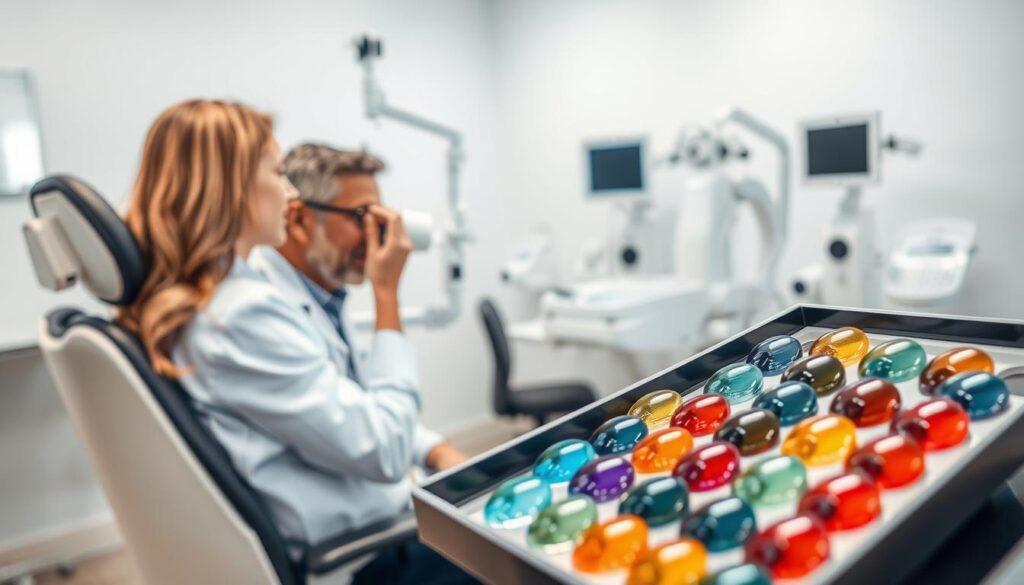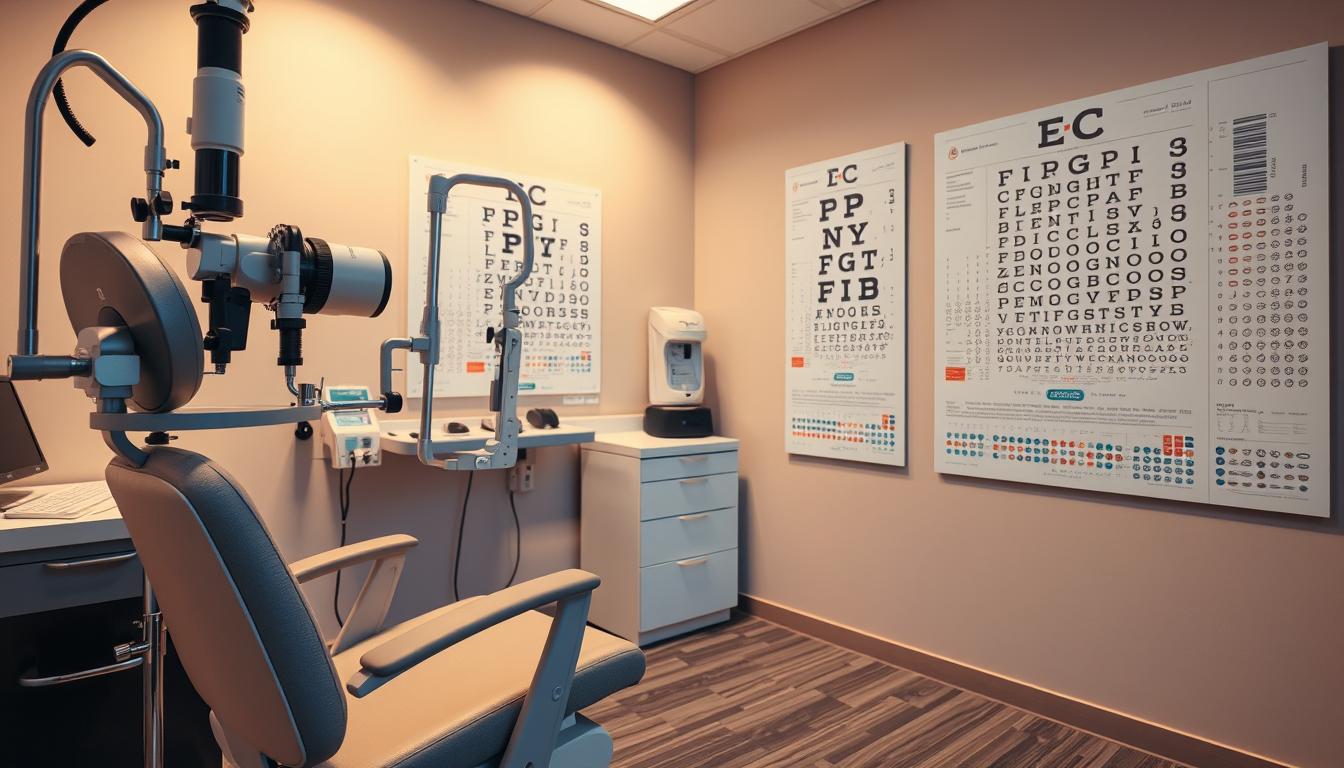Ever wondered what makes an eye exam with contact lenses different from a regular vision test? It’s important to know the details if you’re thinking about contact lenses for vision correction. Unlike regular eye exams, which mainly check your eye health and how well you see for glasses, a contact lens exam has special tests. These tests make sure the lenses fit well, are comfortable, and are good for your eyes.
We’ll look into the key differences between these exams, what a contact lens exam does, and why seeing an eye care specialist is key. Getting into contact lenses might seem tough at first, but it can be easier than you think!
Key Takeaways
- There are two main types of eye exams: comprehensive eye exams and sight tests.
- Rigid gas permeable (RGP) contact lenses typically require a 2–4 week breaking-in period.
- Soft contact lenses generally have a shorter adaptation period.
- Patients using contact lenses long-term may experience issues with the ocular surface.
- Consulting an eye care specialist can ensure you receive a tailored exam to fit your unique needs.
- In children’s exams, early detection can help prevent vision issues that may impact learning.
What is an Eye Exam with Contact Lenses?
An eye exam for contact lenses checks if you’re a good fit for them. It’s different from regular eye exams, which focus on your vision and overall eye health. A contact lens exam looks closely at your eye’s shape and health to find the best lenses for you.
Difference Between Regular Eye Exams and Contact Lens Exams
Regular eye exams check how well you see and your eye’s health with standard tests. Contact lens exams add more tests to see if you can wear lenses comfortably. This is key for getting the right lenses for your eyes.
- Regular Eye Exams: Measure visual acuity and assess general eye health.
- Contact Lens Exams: Include specialized tests for corneal curvature, pupil size, and tear film quality.
Purpose of a Contact Lens Exam
The main goal of a contact lens exam is to see if you can safely wear lenses. It checks for issues like dry eyes or astigmatism that might stop you from wearing them. You’ll talk with your eye doctor to find lenses that fit your lifestyle and vision needs.
| Aspect | Regular Eye Exams | Contact Lens Exams |
|---|---|---|
| Focus | Visual acuity and eye health | Compatibility and fitting for contact lenses |
| Tests Involved | Refraction tests and general assessments | Cornea measurements, pupil and iris measurements, tear film evaluations |
| Cost | Generally lower | Higher due to additional tests |
| Frequency | Every 1-2 years | Annual follow-up exams required for contact lens prescriptions |
Both exams are important. Regular visits keep your eyes healthy, and fitting contact lenses right improves your vision.
Eye Exam with Contact Lenses Meaning
Getting contact lenses means you need a special eye exam. This exam is more than a basic vision check. It makes sure you can wear lenses safely and comfortably.
Understanding the Process of a Contact Lens Exam
The first step is checking your eye health closely. An optometrist will look for issues like dryness, allergies, and infections. These can affect how comfortable lenses are.
Having the right prescription is key. It helps lenses fit right on your cornea. You might try lenses during your visit to see how they feel and work for you.
Critical Measurements Taken
Important measurements are taken during your fitting. These include:
- Curvature of the cornea: Measured with a keratometer.
- Size of the cornea: Needed for the right lens size.
- Pupil and iris size: Important for choosing the right lens type.
- Tear film quality: Checks if you’re good for certain lenses, especially if you have dry eyes.
These steps help create a contact lens prescription just for you. It makes wearing lenses more comfortable.
What to Expect During Your Contact Lens Appointment
Going to an eye care specialist for contact lenses is key to making sure they fit you well. You’ll go through tests to check your eye health and if you’re a good match for contact lenses.
Tests Included in the Exam
The contact lens exam has several tests to check your vision and eye health. These tests include:
- Visual acuity tests to see how clearly you can see.
- Exams of your eye surface to look for any issues.
- Retinal checks to make sure your eyes are healthy.
- Corneal curvature measurements to find the right contact lens size.
- Checks on tear film quality to make sure your eyes are moist enough for lenses.
About 90% of people successfully switch to contact lenses with these tests. They help figure out if you’re a good candidate and make sure you’re comfortable and see well.
Trial Lens Fitting
After taking your measurements, you’ll get trial contact lenses to wear during your visit. This step lets the specialist see how:
- Your vision and comfort are with the lenses.
- The lenses sit right on your cornea.
- You might need any changes or adjustments.

You’ll wear these trial lenses for 1-2 weeks before another check-up. This time is crucial to see how you adjust to wearing lenses daily. You might be offered different types, like soft lenses or ones for specific vision needs.
At your follow-up visit, you’ll have more tests, like slit lamp exams and fitting checks. These make sure your lenses fit well and help you see clearly. Keeping your lenses clean and your eyes moist is important to avoid problems and make wearing lenses better.
| Test | Purpose |
|---|---|
| Visual Acuity Test | To measure how clearly you see. |
| Corneal Measurements | To determine proper fit and check for astigmatism. |
| Tear Film Assessment | To ensure adequate moisture for lens comfort. |
| Trial Lens Fitting | To evaluate comfort and clarity pre-prescription. |
Conclusion
Understanding the eye exam for contact lenses is crucial for a smooth vision care journey. This exam checks your vision, eye health, and how well you’ll fit with contact lenses. It’s important to see an eye care expert who can give advice tailored to you.
Make sure to get both regular eye exams and contact lens exams. This saves you from extra tests and costs. Annual check-ups are key to keeping an eye on your vision and any changes. For more info on why these exams are important and their costs, check out this resource.
Looking after your contact lenses is key to avoiding problems and infections. Always follow what your eye doctor says about wearing, cleaning, and check-ups. Being proactive with your eye health means you can safely enjoy the ease and benefits of contact lenses.



